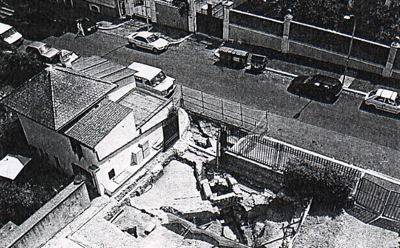

 .
.
![]() outlined its general position, but in 1912, the men on the construction site knew its precise location. Trajan’s aqueduct cut across the foundations of what was shaping up to be the new American Academy on top of the Gianicolo, the hill to the south of Rome’s center. Completed under Emperor Trajan in 109 AD, this aqueduct is a marvel of ancient engineering constructed to supplement the already extensive web of waterworks required to ensure the empire’s survival. Typically recognized when it rises above the landscape on a series of arches, here on the Gianicolo, the aqueduct tunnels below grade.
outlined its general position, but in 1912, the men on the construction site knew its precise location. Trajan’s aqueduct cut across the foundations of what was shaping up to be the new American Academy on top of the Gianicolo, the hill to the south of Rome’s center. Completed under Emperor Trajan in 109 AD, this aqueduct is a marvel of ancient engineering constructed to supplement the already extensive web of waterworks required to ensure the empire’s survival. Typically recognized when it rises above the landscape on a series of arches, here on the Gianicolo, the aqueduct tunnels below grade.
Later, in the early third century AD, Romans constructed a mill to harness the hydropower of this aqueduct. Built with foundations of brick-faced concrete, two channels diverted water from the aqueduct to drive five massive grinding wheels. Utilized to grind grain for bread production, the mill was a state run activity, which even oversaw the grains’ distribution.
As the empire fell into decline, Romans grew fearful of barbarians breaching their city walls. Though aqueducts were the links to water resources beyond its walls, they could potentially provide entry to resourceful invaders. In an effort to outwit the surrounding Goths, Romans blocked their aqueducts in 537, as ordered by the Byzantine emperor Belisarius. Nevertheless, the city did fall–-several times.
In modern times, the property at the top of the Gianicolo passed to other interlopers, this time to the American Academy thanks to the financier J. P. Morgan. Reflective of America’s new forward position in the world, the architectural firm of McKim Mead and White designed an expansive new home. By the autumn of 1914, construction on the building was complete and the academy soon bustled with activity above as the ancient aqueduct sat quietly below.
Recent excavations led by the celebrated English archeologist Andrew Wilson, brought to light the ancient mill foundations and the stone fill that attempted to hold back the invasion. A fill that included stone statuary and architectural fragments. Now recognized as a significant remnant to this fascinating episode in Rome’s history, it is necessary to expose, safeguard and provide access to this intriguing archeological site.
To exhibit these low rising artifacts, Pools of Pleasure reveals the mill’s foundations in a shallow reflecting pool forming a shimmering display of archeology. Sunning platforms and picnic tables encircle this pool and its contents. Given a place of pride, these artifacts are both the nucleus and point of departure for the larger project.
Mimicking the orientation of the ancient water flow, a second pool aligns with the aqueduct of Trajan. Elevated a few meters above and cantilevered over Via Giacomo Medici, this new lap pool intersects the academy in its most central room–-the salone. Swimmers access the starting block from within this room to initiate their outdoor swim along the length of this 50-meter pool. A one-way mirror bordering with an adjacent room permits voyeuristic entertainment of the pool while these viewers attend to other duties.
A third contiguous pool, dedicated to diving, runs along the site’s eastern boundary. Together, Pools of Pleasure not only illuminates the site’s initial hydro-significance, it provides a lush amenity for the Fellows of the American Academy. It’s an indulgence even its founder, Charles McKim, would have taken great delight in on a hot Roman summer’s day.




